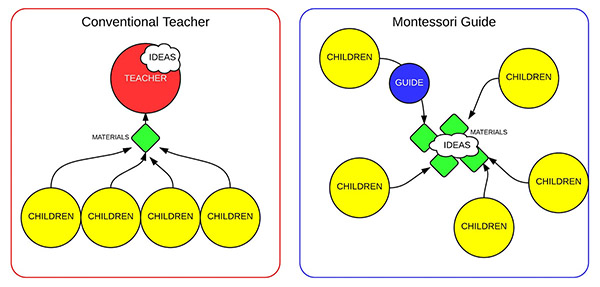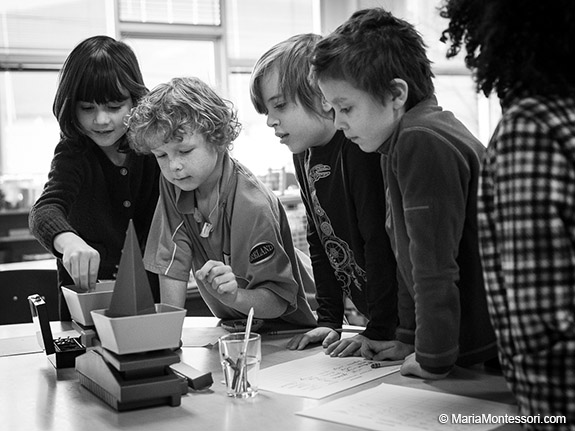When we hear a title or label our mind conjures images and stereotypes from memory and repeated experience. The stereotypical role of the conventional teacher is so different from the role of trained Montessori adults working with children in a prepared environment, that the term teacher misleads and confounds our understanding. It is for this reason that I consciously choose the term Guide.
Dr. Maria Montessori described the Guide’s role
“Summing up her principal duty in school practice, one may state thus the mistress must explain the use of material. She is, in the main, a connecting link between the material (the objects) and the child. A simple, modest duty, and yet much more delicate than when in the old schools, the material was, on the other hand, a simple connecting link, helping to establish intellectual correspondence between the mistress, who had to pass on her ideas, and the child who had to receive them.” (Montessori p206, emphasis mine)
In a conventional classroom, the Teacher is the source of knowledge and she may use a myriad of approaches to transmit her understanding of a concept to the children. She may lecture or use materials (books, videos, manipulable, games, or activities). More progressive Teachers create “discovery-based” lessons or engage in “inquiry-based” learning, which means they plan lessons that allow children to discover particular learning or try to pursue the interest of the children. Methods may vary, but the structure of a conventional classroom continues to be a Teacher shepherding children as a group through a scheduled curriculum (a particular lesson at a particular time).
Dr. Maria Montessori further explains;
“In our system, the mistress does nothing more than facilitate and make clear to the child, the very active and prolonged work which is reserved for him, in choosing objects, and employing himself with them.” (Montessori p.206, emphasis mine)
The key difference between a conventional classroom and a Montessori environment is found in the scientifically designed materials. The knowledge and concepts the child will learn are no longer to be found only in the adult but are now also made manifest in the materials. Children are able to independently interact with materials (after a presentation) and learn without the direct involvement of the adult. Everyone is liberated in this structure; children can follow their interests through a non-scheduled curriculum and the adult is free to Guide individual children as needed.

I believe that the role of the Montessori Guide is very much like the role of a good party host.
- A good host diligently prepares the location for safety and ambiance
- A Guide prepares the environment
- A good host carefully prepares the guest list to ensure an enjoyable evening
- A Guide prepares a list of materials and children to ensure developmentally appropriate activities are available
- A good host greets guests
- A Guide greets the children each morning
- A good host introduces guests who she thinks have a common interest
- A Guide presents materials to children who are interested and ready
- A good host observes and moves as needed to engage bored guests, never staying too long with any individual or group
- A Guide observes and moves as needed to inspire learning, never staying too long with any individual or group
- A good host knows that her purpose is not to entertain the guests, but to facilitate connections between guests.
- A Guide knows that her purpose is not to Teach, but to connect children with meaningful work that will impart knowledge through its correct use.
- A good host gracefully diffuses conflicts
- A Guide gracefully diffuses conflicts
Education is a challenging field, and both Teachers and Guides are highly trained professionals drawn to this work by a deep love of children and a fascination with learning. However, the methods and mindset are so very different that it is appropriate to have a different title.
Montessori, Maria. The Discovery of the Child. 1948. Reprint. Madras, India: Kalakshetra Press, 1966. Print.
